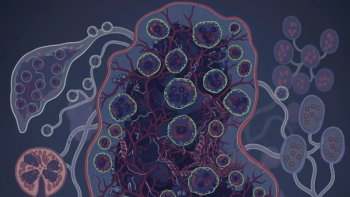
- Rare Cancers Special Issue
- Volume 1
- Issue 1
Making It Personal With Waldenstrom's Macroglobulinemia
Treating relapsed Waldenstrom’s macroglobulinemia takes an individualized approach from a growing list of options.
When it comes to treating relapsed or therapy-resistant Waldenstrom’s macroglobulinemia (WM), the watchword is “personalization.”
“Every patient is different — the clinical features of (their cases), their genomic profiles, as well as comorbidities and medications — and we need to take all those factors into account to choose the best therapies after initial treatment,” said Dr. Jorge J. Castillo, clinical director of the Bing Center for Waldenstrom’s Macroglobulinemia at Dana-Farber Cancer Institute in Boston and an associate professor at Harvard Medical School.
Castillo and several others discussed progress in the treatment of WM before an audience of 1,300 from 29 countries during an April 10 webcast. The event was sponsored by the
A rare blood cancer, WM is a type of non-Hodgkin lymphoma. In this disease, cancer cells, specifically malignant plasma cells that normally make antibodies, produce an abnormal protein that crowds out normal cells in bone marrow, thickens the blood and can cause anemia, bleeding, bruising and infection.
In some cases, newly diagnosed WM needs no treatment beyond careful observation. If symptoms warrant treatment, the choices are clear: either chemotherapy paired with the targeted drug Rituxan (rituximab) or the targeted drug Imbruvica (ibrutinib) given by itself or with Rituxan, explained Dr. Stephen M. Ansell, a professor of medicine at Mayo Clinic College of Medicine and Science in Rochester, Minnesota and a consultant with the department of internal medicine there.
It’s when the disease stops responding to initial therapy or comes back after a remission that treatment decisions become more complicated.
CHOOSING TREATMENTS AFTER RELAPSE OR DRUG RESISTANCE
When determining treatment, oncologists have patients’ quality of life in mind, Castillo said.
“The reason we begin treatments for WM is because quality of life is affected or threatened by recurring infections, anemia, hyperviscosity (thickness) of blood or fluid in the lungs that could lead to meningitis,” he said. “Improved quality of life is the outcome we’d like to see when we treat patients.”
Castillo outlined the three main treatment courses he considers when a patient’s disease recurs or becomes resistant to initial therapies:
- The chemotherapies bendamustine and cyclophosphamide (or others) combined with Rituxan, which kills blood cells marked with the protein CD20, most of which are cancerous.
- A targeted drug known as a proteasome inhibitor — usually, Velcade (bortezomib), Kyprolis (carfilzomib) or Ninlaro (ixazomib). These drugs stop a process inside cells that clears away unneeded proteins; without that process, the proteins accumulate and the cells blow up.
- A targeted drug known as a Bruton tyrosine kinase (BTK) inhibitor, such as Imbruvica, alone or with Rituxan. This type of drug inhibits the multiplication rate of cancer cells.
Although there is no established order for trying these options, Castillo said he prefers to start with chemotherapy/Rituxan and then, if necessary, move to a proteasome or BTK inhibitor — or the two combined. If the cancer grows after that, he typically treats it with chemotherapy, using symptoms and other indices of cancer burden to make decisions on treatment timing and type.
“Those are the three big options that are safe (and) effective and provide patients with good quality of life and good response, moving forward, for years,” he said. “Sequencing of these is less under- stood, but in our experience, we’ve seen that patients who respond very well to initial therapies and then lose response do respond to the next line of treatments.”
Ansell mentioned another option for relapsed or resistant disease: Venclexta (venetoclax), which blocks the activity of the protein BCL-2, sending a message to cancer cells to self-destruct. Although it is approved by the Food and Drug Administration for use in relapsed or resistant WM, it’s likely to soon be OK’d for use as an initial treatment, according to Ansell.
“What’s exciting is that it is now being used in combination with BTK inhibitors and has been shown to be highly effective and well tolerated,” he said. “In the future, it may be used more in combination with other, more standard therapies to get very durable remissions.”
Finally, stem cell transplant using a patient’s own stem cells can be a treatment option for WM. “The role of that in WM is not defined,” Castillo said. “Some doctors feel it needs to be used earlier in treatment, and some feel it should be used later.” In his opinion, stem cell transplant should be considered in patients whose disease has progressed despite several previous courses of treatment.
Patients with WM should not undergo allogeneic stem cell transplant, which uses donor cells, except within the confines of a clinical trial, he said.
Additional drugs fill the WM toolbox, but they can cause more troublesome side effects. “We use the agents we feel are more effective and less toxic early and then leave the less effective, more toxic drugs for later,” Castillo said.
To further personalize treatment, oncologists use genetic profiling of patients’ cancers to determine which drugs are likely to work the best. Castillo said that 90% of patients with WM have a mutation in the MYD88 gene and about one-third carry a mutation in the CXCR4 gene.
“It seems that patients who don’t carry MYD88 mutations might not respond as well to ibrutinib as patients with the MYD88 mutation,” he said. “Similarly, patients with the CXCR4 mutation might have a shorter, more superficial response to ibrutinib compared (with) patients without it. So, with ibrutinib, knowing the genetic profile of a patient’s cancer could help inform decisions about which drug to use next.”
Castillo noted that genetic profiling does not help in decisions about whether to give chemotherapy, Rituxan or proteasome inhibitors in WM.
Future clinical trials of treatments for WM are likely to be driven by genetic profiling, he added: “We have a clinical trial running at Dana-Farber in which we are combining an antibody against CXCR4 with ibrutinib. In the future, more clinical trials might have these components (to help identify the patients) we believe might be better suited.”
CONSIDERING SIDE EFFECTS
It’s reasonable for patients and their doctors to consider potential side effects of medications when choosing treatments, Castillo said. “Some treatments (including Rituxan, Imbruvica and bendamustine) are more problematic, giving patients low blood counts so that they may need transfusions or growth factors (which cause bone marrow to produce more blood cells),” he said. “Other combinations cause nausea or constipation, and knowing that in advance helps us take measures to stay ahead of the game.”
Some medications, such as Velcade, result in neuropathy — nerve damage that causes numbness and weakness of the extremities, he added: “We need to be careful about decreasing the dose or spacing the cycles to minimize those problems.”
Castillo noted that neuropathy can also be caused by the disease, and affects one in four patients he treats for WM.
It’s important to determine the reason for the neuropathy before treating it in patients with WM, according to Castillo. “We need to prove that neuropathy is related to the disease,” he said. “Clinicians may assume there’s a connection, but when they go deeper, (they) find that a patient has diabetes or vitamin B12 deficiency or Lyme disease.” Those conditions can also lead to neuropathy.
Castillo suggested that patients with neuropathy see both a specialist in WM and a neurologist who specializes in neuropathy so that thorough testing will be done. When patients have neuropathy, care teams should avoid WM treatments that may worsen it, he said.
Overall, Castillo said, there is a lot of hope on the horizon for the WM community. “We’re collecting data every year at the national level, and we’ve been encouraged by seeing that the survival of patients with WM keeps getting longer,” he said. “The future is very bright, and what’s coming out of clinical trials and our labs and clinics will help to move the field forward and make patients feel better, live longer and enjoy their lives as much as they can.”
Articles in this issue
about 6 years ago
New Therapies Making Progress in Rare Cancersabout 6 years ago
Hormones Gone Mad in a Rare Type of Ovarian Cancerabout 6 years ago
The Truth About Implantsabout 6 years ago
Studying Rare Diseases Is Difficult, But Innovation Drives Resultsabout 6 years ago
Seeking Immunity: Exploring Kaposi's Sarcomaabout 6 years ago
Blowing a Fuse: Fighting NTRK Gene Fusions in Cancerabout 6 years ago
A Rare Opportunity for Patients With Brain and Spinal Cancers




